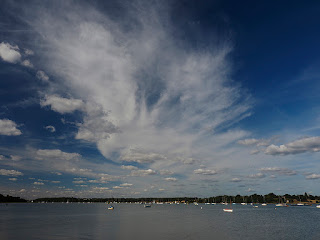 |
| Dedham Parish Church - credit:S |
As it happens Dedham is a delightful little village that's been around a long while - many buildings are medieval. There are a few half timbered buildings but most of the properties along the High Street look Georgian: lots of imposing facades, albeit on a mini scale. Turns out quite a few are really only facades attached much earlier houses and shops. There are no power poles or street lights so it remains very photogenic, if not a little too perfect. We're staying in a Georgian home that has been beautifully renovated. The owner told us how their elderly neighbours pretty much dictate any changes to the village - the council tends to defer to them. On the plus side, their passion has kept the village from being over developed, but on the negative side, it makes renovating a nightmare.
 |
| River Stour - credit:S |
Most of the sites of Constable's Dedham Vale paintings are within walking distance, so we headed off along one of Britain's many public footpaths that cross farmland and other private land. This one went along the banks of the River Stour and over the Stour Bridge where we stopped for morning tea, sitting out under the trees, right next to the dry dock where river barges used to be maintained. These were also a subject of Constable's paintings as were the nearby locks (no longer the originals of course!). It was then a short walk to Flatford Mill, where Constable lived. Right outside Flatford Mill is the pond and Willy Lott's house that feature in the painting The Hay Wain. The sun wasn't at the right angle to do it justice, so we planned to come back closer to sunset - which we did the next day, and this is the result:
 |
| The Hay Wain - credit: S |
 |
| Dedham church a la Constable - credit: J |
 |
| East Bergholt church with bell cage - credit:J |
We found a quaint little tea room for afternoon tea (nothing between a a cream tea!) before wandering back along more footpaths to Dedham. The downside of these public footpaths is that their routes aren't always obvious: we went wrong somewhere, had to climb over a gate, and almost ford a stream (until we saw the little foot bridge) not having the faintest idea where we were until thankfully a few landmarks appeared.
Our hosts recommended a place for dinner that we could walk to - along yet another public farmland footpath. As it was dusk, we saw lots of rabbits. Fortunately the sign "Bull in Field" was not a reason for concern, as the bull was way off the distance. We had a very nice meal before braving the country lane in the dark - no street lights! Still better than the farmland footpath.
23rd Sep
An even more beautiful morning - sunshine with a hint of autumnal crispness. Our charming Airbnb hosts provide us with a more modest healthy breakfast thank heavens, so we don't waddle out the door. I had two aims for today, both related to Arthur Ransome (of Swallow and Amazon fame) rather than Constable for a change. He wrote two books set in this part of England: Secret Water and We Didn't Mean to go to Sea. In both, they start out at Pin Mill on the River Orwell (more of an estuary at this point, as it's close to the coast).
 |
| Hanford Water Reserve - credit: J |
 |
| Pin Mill - credit:S |
 |
| Clouds over the River Orwell - credit:J |
We consumed a leisurely and large lunch at the Butt and Oyster, so no dinner was needed that night. Good old sausage and mash, sticky toffee pud and apple crumble, accompanied by local Suffolk ale and cider.
Then it was back to Flatford to have another go at photographing the view in better light - well worth it as the evening sunshine was beautiful, even if not very much like Constable's dark atmospheric colours. Shame about the jet contrail! (see photo above).
The day ended with a lazy evening at our temporary home, including chatting with our hosts. James is a potter and I had a tour of his studio and the latest pots just out of the kiln this morning. He does domestic pottery, in shades of blues and sage greens, although he is still experimenting, so the colours aren't always as he expects. It was nice to do very little as we were facing a long drive the next day.

No comments:
Post a Comment